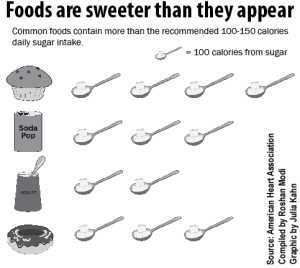Clinical dietician Devon Toia’s patient insisted he was feeling okay until he began experiencing blurriness in his vision.
“He was showing signs of cardiovascular disease, [known as CVD], and it wasn’t in very good control,” said Toia. “We found that because of his sugary diet, his blood-sugar levels were running high and it was damaging the nerves in his eyes.”
As Toia described it, this particular patient had a blood-sugar level of over 300 milligrams per deciliter (mg/dL). She said normal levels should be under 120 mg/dL right after a meal.
A study conducted this year in the Journal of the American Medical Association of Internal Medicine concluded that most Americans consume more artificially added sugar than is recommended for a healthy diet and thus are at an increased risk of CVD.
“Most of the patients I see get more than 10 percent their daily calories from added sugars in foods they eat,” Toia said.
The American Heart Association, known as AHA, recommends that women limit their sugar intake to six teaspoons a day or 100 calories from sugar, and men limit their intake to nine teaspoons of sugar a day or 150 calories from sugar.
While generally maintaining a standard 2,000 calorie diet, juniors Kevin Du and Jacki Erens and senior Jami Weinstein were asked to record the foods they ate over the course of a weekend. On average, Weinstein and Erens ate nearly 415 calories from sugar per day, more than four times as much as the recommended amount. Du averaged 285 calories from sugar per day over the two-day period, nearly double the recommended amount.

Erens said last year in health class she participated in a project in which students recorded the foods they ate and received the nutrition labels after recording each food.
“You just saw when you read the nutrition labels how much sugar is in everything, like even milk,” Erens said.
Weinstein said it is difficult for students to cut down on sugary items because of how students are constantly surrounded by sugary food choices.
“So many people go to the cafeteria and buy candy because there are just so many candy options,” said Weinstein. “I think [our school] tries to put better options in the cafeteria because they had that healthy section, but ended up changing it to ice cream, so it didn’t really work out.”
Toia said in addition to people being surrounded by sugary foods, the reason why Americans get so many calories from sugar is because companies try to boost the flavor profiles of foods so people will buy them. She described a food’s flavor profile as how appealing the taste is to consumers.
“A lot of added sugar, things like high fructose corn syrup, is a very cheap and easy way for companies to boost the flavor profile [of their food products] so that people will like them and buy more of them,” Toia said.
Du said the real problem for students consuming more sugar lies in the lack of awareness students have in determining what qualifies as too much sugar in foods.
“Even if we do pay attention to food labels, we don’t have a good measure,” said Du. “Like most of the food labels are written in grams and stuff, and I don’t know how many grams of sugar are considered too much or too little.”
Toia agreed that a lot of people do not know what amount constitutes as “too much sugar” and recalled that her patient had trouble admitting that his decreasing health was linked to his diet.
“A lot of it is about educating people to understand the consequences of consuming a lot of sugar,” said Toia. “We are so used to what we eat when we are growing up, and we need to realize the impact that will have on us later in life.”

